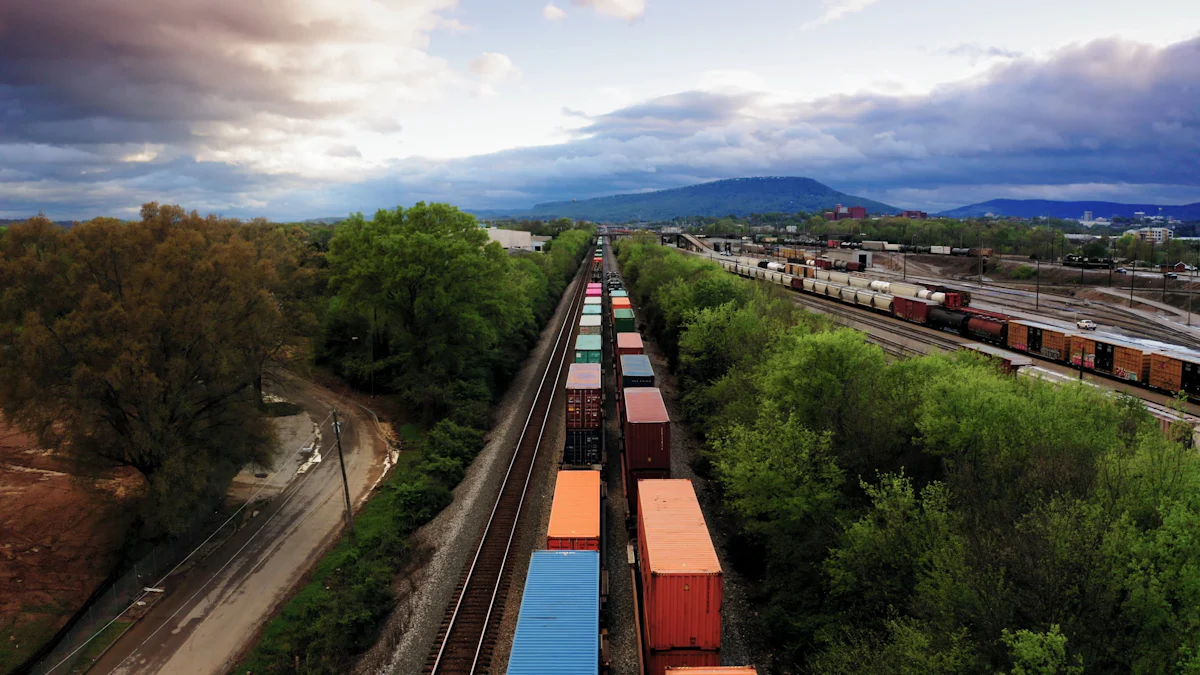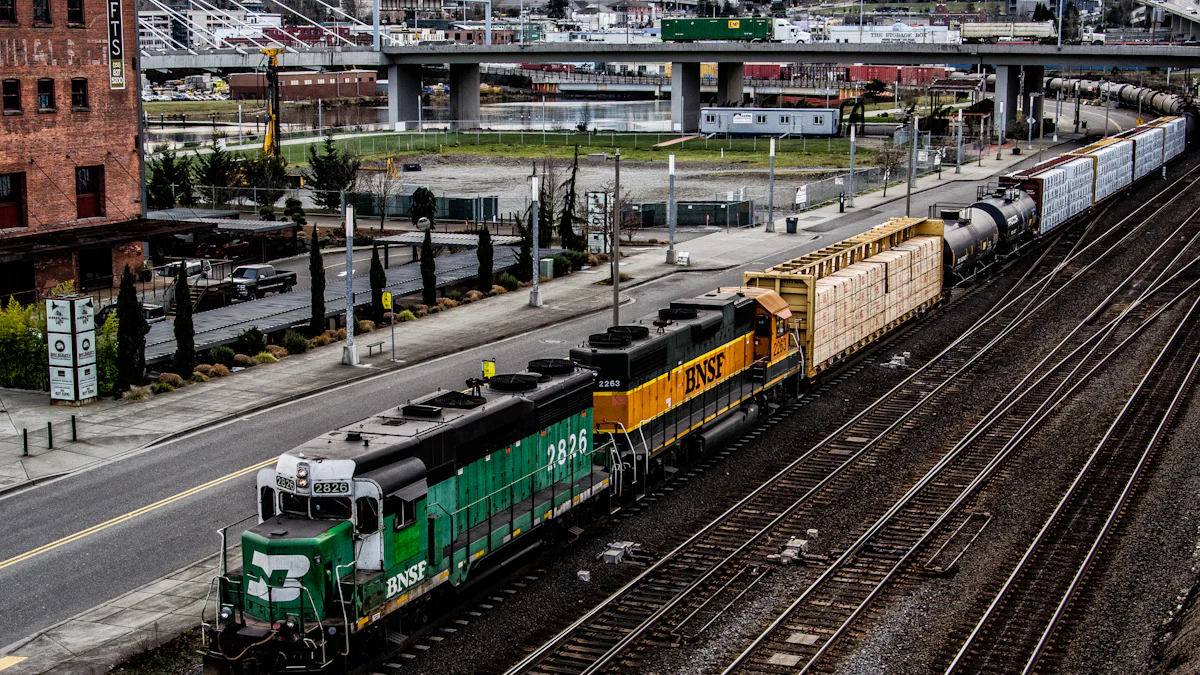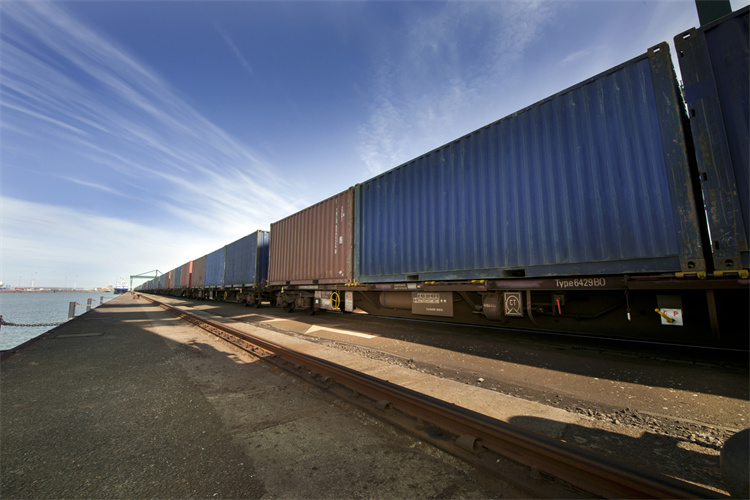How to Ship Goods via Rail Freight: A Step-by-Step Guide

Rail freight plays a crucial role in logistics. It offers numerous benefits for shipping goods. First, rail freight is highly fuel-efficient and environmentally responsible. Trains are four times more fuel-efficient than trucks. They move one ton of freight nearly 500 miles per gallon of fuel. Second, rail freight has a significantly lower carbon footprint compared to truck shipments, reducing greenhouse gas emissions by 75%. Lastly, rail freight provides a fast, reliable, and cost-effective solution for transporting bulk goods. This guide will walk you through the process step-by-step.
What Types of Goods Can Be Shipped via Rail Freight?
Understanding Freight Categories
Bulk Commodities
Rail Freight excels in transporting bulk commodities. These include coal, grain, and minerals. Trains can carry large quantities efficiently. This makes Rail Freight ideal for industries needing to move massive amounts of raw materials.
Intermodal Containers
Intermodal containers are another common type of cargo. These containers can switch between trucks, ships, and trains without unloading. This versatility makes Rail Freight a key player in global logistics. Containers can hold consumer goods, electronics, and textiles.
Specialized Freight
Specialized freight includes items requiring unique handling. Automobiles often travel in closed or open autoracks. Steel pallets use coil cars. Refrigerated goods like fruits and vegetables use refrigerator cars. Rail Freight offers solutions for various specialized needs.
Restrictions and Limitations
Hazardous Materials
Shipping hazardous materials involves strict regulations. Rail Freight can transport chemicals, batteries, and paint. However, shippers must follow safety protocols. Proper labeling and documentation are crucial. Compliance ensures safe and legal transport.
Perishable Goods
Perishable goods present another challenge. Rail Freight can handle refrigerated items. Refrigerator cars maintain the needed temperature. However, timing is critical. Delays can spoil perishable goods. Efficient planning minimizes risks.
How to Prepare Your Goods for Rail Shipping?

Packaging Requirements
Proper packaging ensures that goods arrive safely. Rail Freight demands durable packaging materials to withstand the journey.
Durable Packaging Materials
Choose strong materials like corrugated cardboard, wooden crates, or metal containers. These materials protect goods from damage during transit. Avoid flimsy packaging that can break easily. Reinforce packages with extra padding or cushioning for fragile items.
Labeling and Documentation
Label each package clearly. Use waterproof labels to prevent smudging. Include essential details like destination, sender's address, and handling instructions. Proper documentation is crucial for Rail Freight. Ensure all paperwork is accurate and complete. Missing documents can delay shipments.
Securing the Cargo
Securing cargo prevents movement during transit. Properly secured goods reduce the risk of damage.
Palletizing
Palletizing involves stacking goods on a pallet. Use wooden or plastic pallets. Arrange items evenly to distribute weight. Secure items with stretch wrap or shrink wrap. Palletizing makes loading and unloading easier for Rail Freight.
Strapping and Wrapping
Strap goods tightly to the pallet. Use strong straps made of steel or polyester. Wrapping adds an extra layer of protection. Stretch wrap keeps items together and shields them from dust and moisture. Proper strapping and wrapping ensure stability during the Rail Freight journey.
What Are the Costs Involved in Rail Freight?
Understanding Pricing Factors
Distance and Route
Rail Freight costs depend heavily on distance and route. Longer distances often result in lower costs per mile. Railroads can transport vast quantities of materials efficiently. This efficiency makes Rail Freight cost-effective for long hauls. The chosen route also impacts pricing. Direct routes with fewer stops reduce costs. Complex routes with multiple transfers increase expenses.
Weight and Volume
Weight and volume play crucial roles in determining costs. Heavier and bulkier shipments cost more to transport. Rail Freight charges based on tonnage and space occupied. Large volumes benefit from economies of scale. Shipping large quantities reduces the cost per unit. Properly packing goods maximizes space and minimizes costs.
Additional Fees and Charges
Handling Fees
Handling fees cover the loading and unloading of goods. Rail Freight services include these fees in the overall cost. Efficient handling reduces the risk of damage. Proper packaging and labeling minimize handling time. These factors contribute to lower handling fees.
Insurance Costs
Insurance costs protect against potential losses. Rail Freight offers various insurance options. Basic coverage includes protection against common risks. Comprehensive coverage provides additional security. Shippers should evaluate the value of their goods. Higher-value items may require more extensive insurance. Proper insurance ensures peace of mind during transit.
How to Choose the Right Rail Freight Service?
Evaluating Service Providers
Reputation and Reliability
Finding a trustworthy rail freight service starts with checking reputation. Look for reviews from other businesses. Positive feedback indicates reliability. A company with a strong track record usually delivers on promises. Consistent performance matters in logistics. Reliable providers ensure timely deliveries.
Service Coverage
Service coverage plays a crucial role. Some providers operate only in specific regions. Others offer nationwide or even international services. Choose a provider that covers your shipping destinations. Broad coverage means fewer transfers. Fewer transfers reduce the risk of delays and damage.
Comparing Service Options
Direct Rail Services
Direct rail services transport goods from point A to point B without switching modes. This option suits bulk shipments. Direct services often cost less due to fewer handling fees. The simplicity of direct routes minimizes the risk of delays. Direct rail services provide a straightforward solution for many businesses.
Intermodal Services
Intermodal services combine rail with other transportation modes. These options include trucks and ships. Intermodal services offer flexibility. Goods can move seamlessly between different transport types. This versatility benefits global supply chains. Intermodal services handle various cargo types efficiently.
What Are the Steps to Book a Rail Freight Shipment?

Initial Inquiry and Quotation
Providing Shipment Details
Start by gathering all necessary shipment details. Include information like the type of goods, weight, dimensions, and destination. Accurate details help service providers give precise quotes. Contact the chosen rail freight service provider. Provide all gathered information. This step sets the foundation for a smooth shipping process.
Receiving a Quote
After providing shipment details, request a quote. The service provider will calculate costs based on the provided information. Expect to receive a detailed quote outlining all charges. Review the quote carefully. Ensure it covers all aspects of the shipment. Clarify any doubts with the service provider. A clear understanding of costs helps avoid surprises later.
Confirming the Booking
Finalizing the Contract
Once satisfied with the quote, proceed to finalize the contract. Read the contract thoroughly. Pay attention to terms and conditions. Confirm that all shipment details are accurate. Sign the contract to formalize the agreement. This step secures the booking and sets the terms for the shipment.
Scheduling the Pickup
With the contract finalized, schedule the pickup. Coordinate with the service provider to arrange a convenient time. Ensure the goods are ready for loading on the scheduled date. Proper preparation ensures a smooth pickup process. The service provider will handle the rest. This step marks the beginning of the rail freight journey.
"Rail shipping is one of the oldest forms of freight transportation and is relatively easy to understand." - Logistics Expert
Following these steps ensures a seamless booking process. Proper planning and communication with the service provider make rail freight shipping efficient and hassle-free.
How to Track and Manage Your Shipment?
Tracking Technologies
GPS Tracking
GPS tracking offers real-time updates on shipment locations. This technology provides precise data on the position of railcars. Shippers can monitor the progress of goods throughout the journey. GPS tracking helps ensure timely deliveries and enhances security. Knowing the exact location of shipments reduces uncertainties.
Online Tracking Portals
Online tracking portals offer another layer of convenience. These platforms provide detailed information about shipments. Users can access data on departure times, current locations, and estimated arrival times. Online portals often include features like notifications and alerts. These tools help shippers stay informed and manage logistics more efficiently.
Communication with the Service Provider
Regular Updates
Regular updates from the service provider are crucial. Frequent communication ensures that shippers stay informed about the status of their shipments. Service providers can offer updates on any changes or delays. Consistent updates help in planning and decision-making. Staying in touch with the service provider builds trust and transparency.
Handling Delays and Issues
Handling delays and issues requires prompt action. Shippers should communicate any concerns to the service provider immediately. Quick responses help mitigate potential problems. Service providers can offer solutions or alternatives to address delays. Efficient handling of issues minimizes disruptions in the supply chain.
"RailPulse can be the single source of truth for railcars in the industry by merging the new telemetry data with existing types of railroad data." - Shannon, Rail Freight Tracking Expert
"Your pursuit towards efficient rail freight tracking is not only a necessity but an investment in your supply chain, customer satisfaction, and business continuity." - Montpetit, Digital Solutions for Rail Transport Expert
Shipping goods via rail freight involves several key steps. These include understanding freight categories, preparing goods, evaluating costs, and choosing the right service. Rail freight offers a reliable and efficient shipping method. Businesses can benefit from its cost-effectiveness and environmental advantages.
"Today’s customer seeks continuous updates about their order’s journey. Businesses can meet this expectation through efficient rail freight tracking, leading to improved customer satisfaction."
Consider rail freight for future shipments to enhance logistics efficiency. The reliability and comprehensive tracking options make rail freight a valuable choice for transporting goods.
See Also
Minimizing Costs: The Definitive Logistics Handbook
Navigating Risks: The Essential Supply Chain Safety Manual
Mastering Eco-Friendly Transport in Supply Networks
